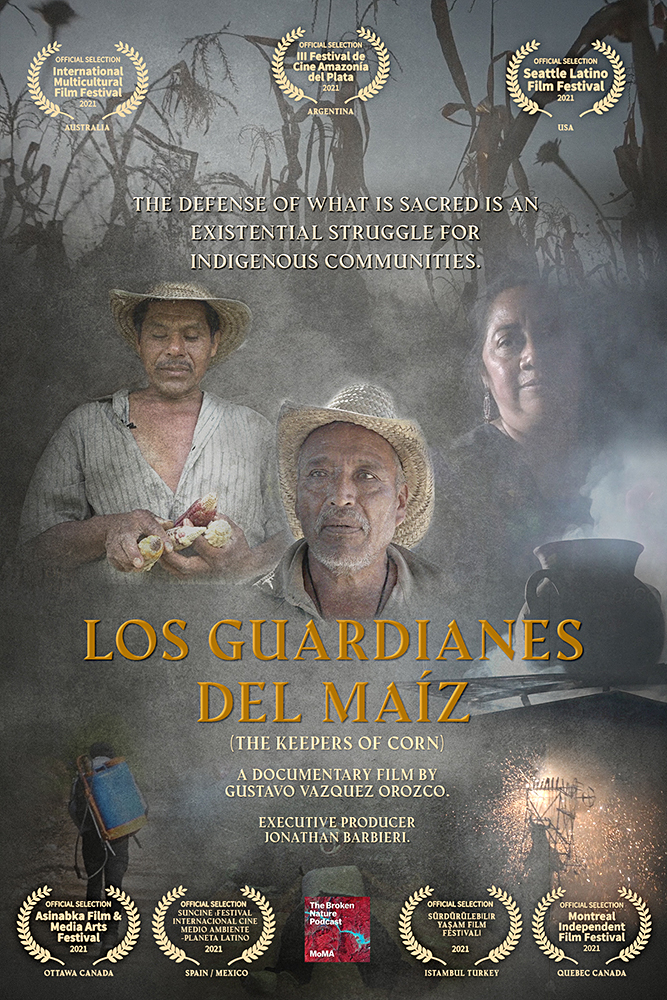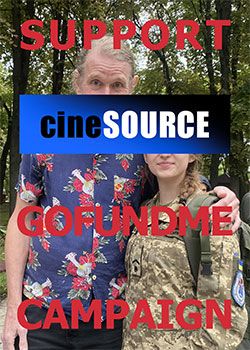SF Docmaker Takes Red Nation Feature Award
by Renée Alexander
Please support our stories by liking articles—thanks!
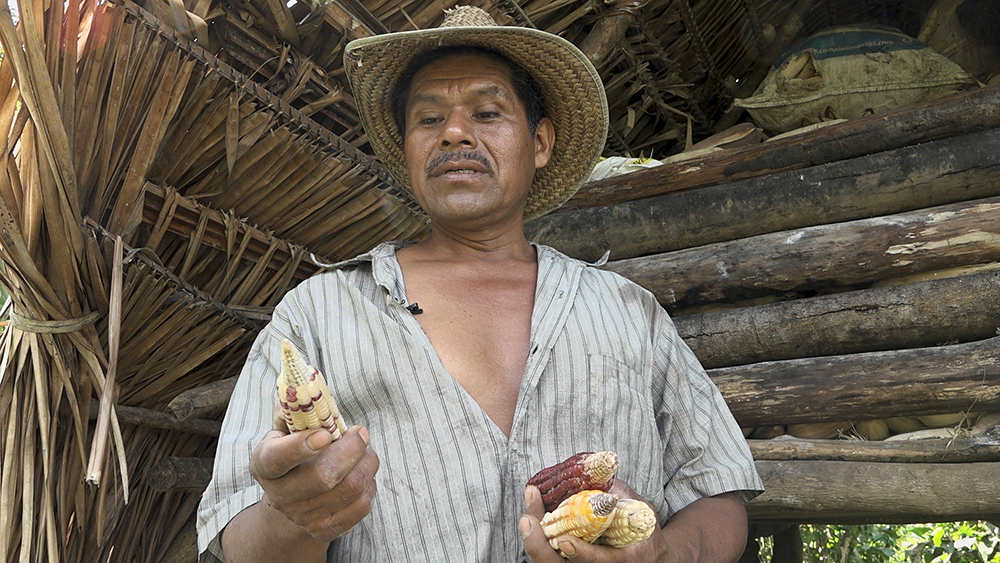 Humberto Concepción Pérez, a farmer from Oaxaca State, Mexico, in Gustavo Vazquez-Orozco's new doc 'Los Guardianes del Maíz'. photo: courtesy G. Vazquez-OrozcoSAN FRANCISCO FILMMAKER GUSTAVO
Humberto Concepción Pérez, a farmer from Oaxaca State, Mexico, in Gustavo Vazquez-Orozco's new doc 'Los Guardianes del Maíz'. photo: courtesy G. Vazquez-OrozcoSAN FRANCISCO FILMMAKER GUSTAVO
Vazquez-Orozco recently brought home the Best International Documentary Feature Film award from the 26th Annual Red Nation International Film Festival in Hollywood.
Having known him for years, I decided to call him up and ask him about the film, “Los Guardianes del Maíz” ("The Keepers of Corn"), which I was privileged to see an advance copy of. It combines scenic views of rural life in Southern Mexico's La Chinantla region with in-depth interviews of indigenous farming families, food sovereignty activists, agricultural organizers, and genetic scientists.
“Los Guardianes del Maíz” explores the resiliency of corn-growing communities and the fragile systems that secure their survival in the face of threats from corporate colonialism, toxic chemicals, climate change, and even Coca-Cola. Ultimately, it reveals the interdependent relationship between corn and humans, which have cultivated each another, as it were, over hundreds of generations.
The film will screen on April 9, 2022 at the Brava Theater, 2781 24th Street, in San Francisco’s historic Mission District. It is a collaboration with Executive Producer Jonathan Barbieri, an artist and alcohol spirits producer Vazquez-Orozco met 45 years ago, while both were students at the San Francisco Art Institute. Vazquez-Orozco is a professor in the film and digital media department at UC Santa Cruz.
The film has shown in numerous festivals around the world, including the Seattle Latino Film Festival, International Multicultural Film Festival in Australia, Festival de Cine Amazonia del Plata in Argentina, SUNCINE Environmental Film Festival in Spain and Mexico, Sustainable Living Film Festival in Turkey, in Canadian festivals and elsewhere.
I caught up with Vazquez-Orozco recently by Zoom.
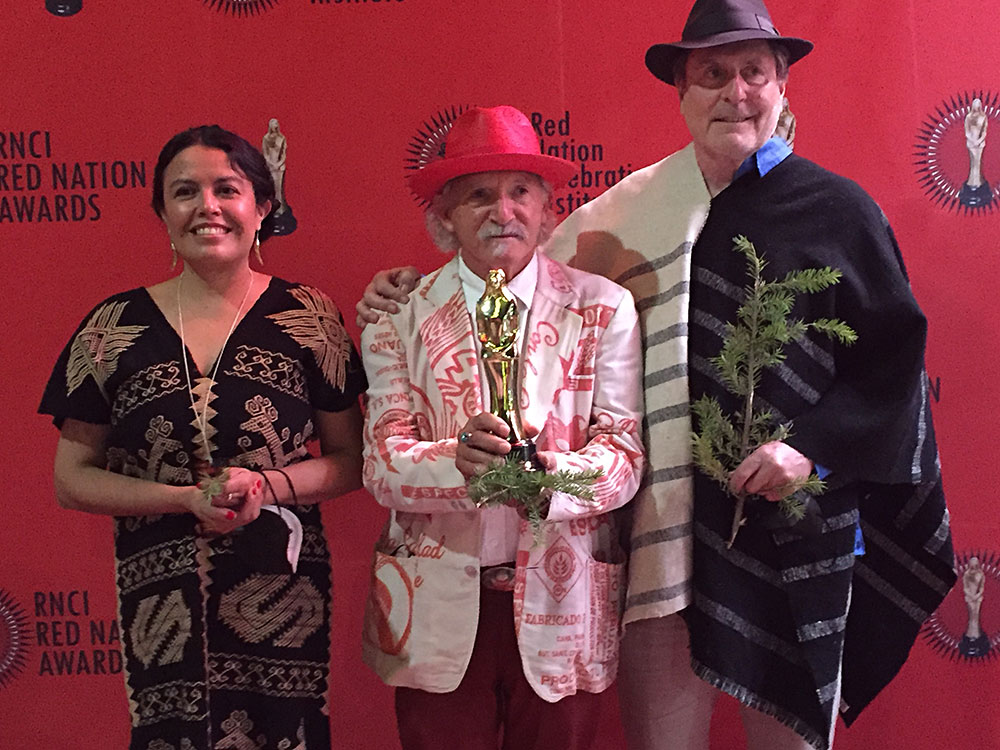 Vazquez-Orozco (center), Executive Producer Jonathan Barbieri (right) and Online Producer Yira Vallejo (left). photo: courtesy G. Vazquez-Orozco cineSOURCE: Who would you say is the hero of this film?
Vazquez-Orozco (center), Executive Producer Jonathan Barbieri (right) and Online Producer Yira Vallejo (left). photo: courtesy G. Vazquez-Orozco cineSOURCE: Who would you say is the hero of this film?
Vazquez-Orozco: The heroes and heroines of the film are all the members of the traditional indigenous communities in Oaxaca [Mexico]. When I would ask a question, such as ‘What do you think about this or that...' consistently the answer was, ‘I don't speak for myself, I speak for my community.'
While the film surveys traditional indigenous agriculture, as a model that can be applied where industrial mono-cropping failed, it is also about people. It explores the cultural continuity that links today's corn farmers in Oaxaca [State, Mexico] to their pre-colonial ancestors.
In the course of our three-year journey, we learned that—even under the stress of bio-piracy, the aggressive promotion of glyphosates [fertilizers], natural disasters, broken promises and the incursion of Maruchan instant soups and Coca-Cola—traditional farming communities have been surprisingly resilient.
Two things make that resilience possible: ‘el tequio,’ and food sovereignty, which are secured by the collective ownership, preservation and diversification of seeds.
What is ‘tequio’?
‘El tequio’ is a term anthropologists use as an approximation for the French word, ‘corvée,’ a form of traditional labor. Westerners tend to think of ‘corvée,’ or statute labor, as some form of unpaid, involuntary conscription.
That could not be further from the truth in the indigenous communities of Oaxaca. Whether for public works such as clearing roads or forest management, or for planting and harvesting corn, ‘el tequio’ is essential to getting things done.
It is actually considered an honor to be called upon to help out, or provide some special skill for the sake of a cause greater than one's self. The practice is as old as agriculture itself and it is critical to the principle that, within the collective, the individual finds meaning.
Where was it shot?
We surveyed Mixtec, Zapotec and Chinantec families in the coastal Sierra Mixteca, Valles Centrales and the lower Chinantla regions [of Oaxaca State]. We got to know Chinanteco farmers and organizers who, for years, have struggled to build a community germplasm bank as a means of protection against chronic seed loss caused by flooding and high winds.
Various institutions have periodically dangled promises of grand projects, but the funding seems always to evaporate before a single stone is laid. Currently, the [seed] bank consists of the plastic storage drums you'll see in the film. The communities in San Mateo Yetla and Plan de las Flores have the land, the labor—el tequio—and, most importantly, the desire to build a model seed bank, if they could secure the necessary funding and access to certain technologies.
How long have those seed banks—
Seed banks in one form or another have been around as long as natural disasters—now, unnatural catastrophes [laughs].
In San Mateo Yetla and Plan de Flores, the destruction of crops by plague, wind or flood means not only the momentary disruption of food supply, but also the loss of the seeds a farmer will need to perpetuate a particular strain of corn, grain or legume. Through painstaking selection, year after year, they have been optimized not only to flourish in the conditions of a particular region, but for the particular wedge of land being cultivated.
It is widely accepted that in Mexico there are about 60 varieties of native corn. More than 35 of those known varieties, some 59% of the total diversity, are found in Oaxaca. But the real number is far greater. Just as Oaxaca's complex landscape has fragmented its 16 indigenous languages into more than 170 tongues, the state's convoluted topography translates into literally hundreds of distinct micro-ecosystems.
The altitude, seasonal rains, soil pH, direction that slope is facing—all of these and more play a part in the evolution of a strain of corn. But, a kernel of Native corn is more than just a package of genes that has evolved over time. It is the culture and history—the intellectual property—of the people who grow it.
The most important factor is the selection each year by the humans who are, to this day, co-evolving alongside that corn. I personally prefer to use words like Native, heritage, or ancestral corn for what has evolved over 350 generations.
Corn does not exist in nature. It cannot self-propagate. Its seeds do not fall naturally to the ground. Vigorous human intervention is required to free the seed from the husk and, through the selection process, humans perfect their corn. Those plastic drums you see in the film—with their limited capacity, sitting on a porch in San Mateo Yetla, Valle Nacional Chinantla—are the only thing standing in the way of the possible destruction of that great legacy.
In the spirit of the tequio, each farmer who wishes to participate in the seed bank makes a deposit of highly selected seeds into the community bank. The seeds are lent out with interest, the return being additional seed. For every kilo lent, two kilos are returned to the bank after the harvest.
Building a secure and operational seed bank in the rainforest conditions of the Chinantla will be no easy task. Heat, humidity, mildew, moisture, weevils, rats, snakes, scorpions, massive storms, earthquakes, power outages, spotty Internet, dengue [fever] and chikungunya [virus] represent just a few of the challenges.
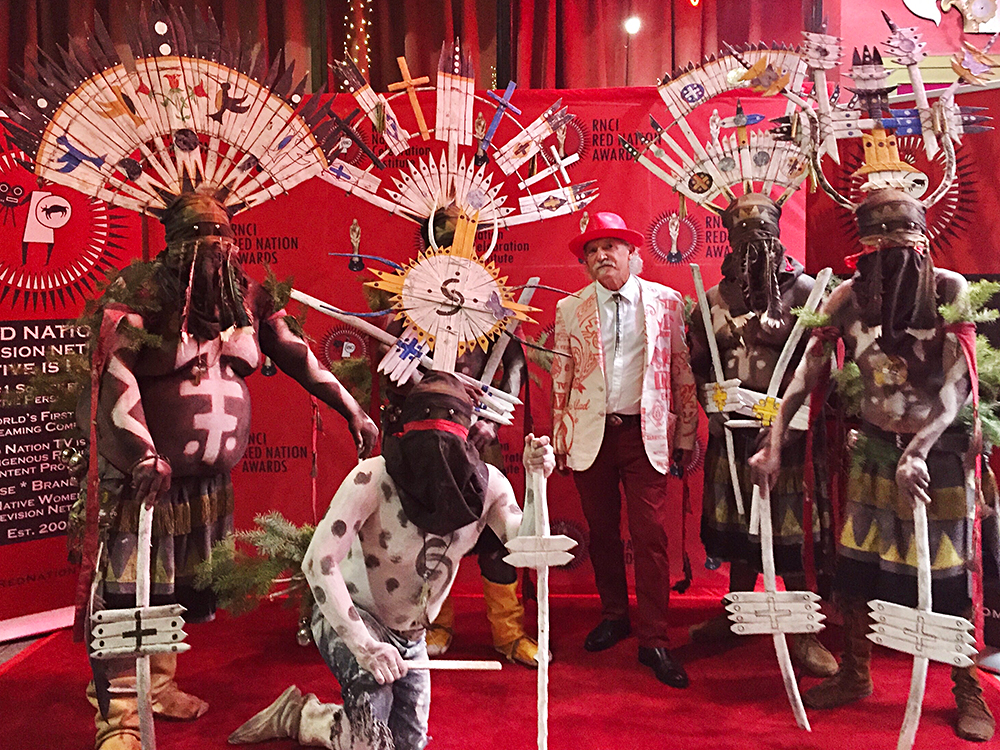 Vazquez-Orozco with Mescalero Apache dancers at the Red Nations Film Festival in Los Angeles, 2021. photo: courtesy G. Vazquez-OrozcoThe building will require sophisticated humidity and temperature control: at what cost? What would the ventilation system look like? How would the seed be stored, labeled and accounted for?
Vazquez-Orozco with Mescalero Apache dancers at the Red Nations Film Festival in Los Angeles, 2021. photo: courtesy G. Vazquez-OrozcoThe building will require sophisticated humidity and temperature control: at what cost? What would the ventilation system look like? How would the seed be stored, labeled and accounted for?
How about the farmers?
The farmers in these two communities are eager to take on these challenges. All they lack is funding and guidance. As filmmakers—as artists—we are adamant interventionists, friends of the people we filmed, advocates and fundraisers. By making the film, we became morally bound to the communities we studied.
Our goal in producing ‘Los Guardianes del Maíz’ is to raise outside awareness and bring these communities into a world conversation. We hope to leverage ‘Guardianes’ to attract state-of-the-art materials and technologies, along with the funding needed to create in the Chinantla a model of what a community seed bank can be. The will and the manpower are already there.
Renée Alexander is a San Francisco-based freelance journalist and travel bug collector who has published stories about food, booze, science, and culture from four continents. Her portfolio is here and email.
Posted on Jan 02, 2022 - 10:20 PM
by Renée Alexander
Please support our stories by liking articles—thanks!
 Humberto Concepción Pérez, a farmer from Oaxaca State, Mexico, in Gustavo Vazquez-Orozco's new doc 'Los Guardianes del Maíz'. photo: courtesy G. Vazquez-Orozco
Humberto Concepción Pérez, a farmer from Oaxaca State, Mexico, in Gustavo Vazquez-Orozco's new doc 'Los Guardianes del Maíz'. photo: courtesy G. Vazquez-OrozcoVazquez-Orozco recently brought home the Best International Documentary Feature Film award from the 26th Annual Red Nation International Film Festival in Hollywood.
Having known him for years, I decided to call him up and ask him about the film, “Los Guardianes del Maíz” ("The Keepers of Corn"), which I was privileged to see an advance copy of. It combines scenic views of rural life in Southern Mexico's La Chinantla region with in-depth interviews of indigenous farming families, food sovereignty activists, agricultural organizers, and genetic scientists.
“Los Guardianes del Maíz” explores the resiliency of corn-growing communities and the fragile systems that secure their survival in the face of threats from corporate colonialism, toxic chemicals, climate change, and even Coca-Cola. Ultimately, it reveals the interdependent relationship between corn and humans, which have cultivated each another, as it were, over hundreds of generations.
The film will screen on April 9, 2022 at the Brava Theater, 2781 24th Street, in San Francisco’s historic Mission District. It is a collaboration with Executive Producer Jonathan Barbieri, an artist and alcohol spirits producer Vazquez-Orozco met 45 years ago, while both were students at the San Francisco Art Institute. Vazquez-Orozco is a professor in the film and digital media department at UC Santa Cruz.
The film has shown in numerous festivals around the world, including the Seattle Latino Film Festival, International Multicultural Film Festival in Australia, Festival de Cine Amazonia del Plata in Argentina, SUNCINE Environmental Film Festival in Spain and Mexico, Sustainable Living Film Festival in Turkey, in Canadian festivals and elsewhere.
I caught up with Vazquez-Orozco recently by Zoom.
 Vazquez-Orozco (center), Executive Producer Jonathan Barbieri (right) and Online Producer Yira Vallejo (left). photo: courtesy G. Vazquez-Orozco
Vazquez-Orozco (center), Executive Producer Jonathan Barbieri (right) and Online Producer Yira Vallejo (left). photo: courtesy G. Vazquez-OrozcoVazquez-Orozco: The heroes and heroines of the film are all the members of the traditional indigenous communities in Oaxaca [Mexico]. When I would ask a question, such as ‘What do you think about this or that...' consistently the answer was, ‘I don't speak for myself, I speak for my community.'
While the film surveys traditional indigenous agriculture, as a model that can be applied where industrial mono-cropping failed, it is also about people. It explores the cultural continuity that links today's corn farmers in Oaxaca [State, Mexico] to their pre-colonial ancestors.
In the course of our three-year journey, we learned that—even under the stress of bio-piracy, the aggressive promotion of glyphosates [fertilizers], natural disasters, broken promises and the incursion of Maruchan instant soups and Coca-Cola—traditional farming communities have been surprisingly resilient.
Two things make that resilience possible: ‘el tequio,’ and food sovereignty, which are secured by the collective ownership, preservation and diversification of seeds.
What is ‘tequio’?
‘El tequio’ is a term anthropologists use as an approximation for the French word, ‘corvée,’ a form of traditional labor. Westerners tend to think of ‘corvée,’ or statute labor, as some form of unpaid, involuntary conscription.
That could not be further from the truth in the indigenous communities of Oaxaca. Whether for public works such as clearing roads or forest management, or for planting and harvesting corn, ‘el tequio’ is essential to getting things done.
It is actually considered an honor to be called upon to help out, or provide some special skill for the sake of a cause greater than one's self. The practice is as old as agriculture itself and it is critical to the principle that, within the collective, the individual finds meaning.
Where was it shot?
We surveyed Mixtec, Zapotec and Chinantec families in the coastal Sierra Mixteca, Valles Centrales and the lower Chinantla regions [of Oaxaca State]. We got to know Chinanteco farmers and organizers who, for years, have struggled to build a community germplasm bank as a means of protection against chronic seed loss caused by flooding and high winds.
Various institutions have periodically dangled promises of grand projects, but the funding seems always to evaporate before a single stone is laid. Currently, the [seed] bank consists of the plastic storage drums you'll see in the film. The communities in San Mateo Yetla and Plan de las Flores have the land, the labor—el tequio—and, most importantly, the desire to build a model seed bank, if they could secure the necessary funding and access to certain technologies.
How long have those seed banks—
Seed banks in one form or another have been around as long as natural disasters—now, unnatural catastrophes [laughs].
In San Mateo Yetla and Plan de Flores, the destruction of crops by plague, wind or flood means not only the momentary disruption of food supply, but also the loss of the seeds a farmer will need to perpetuate a particular strain of corn, grain or legume. Through painstaking selection, year after year, they have been optimized not only to flourish in the conditions of a particular region, but for the particular wedge of land being cultivated.
It is widely accepted that in Mexico there are about 60 varieties of native corn. More than 35 of those known varieties, some 59% of the total diversity, are found in Oaxaca. But the real number is far greater. Just as Oaxaca's complex landscape has fragmented its 16 indigenous languages into more than 170 tongues, the state's convoluted topography translates into literally hundreds of distinct micro-ecosystems.
The altitude, seasonal rains, soil pH, direction that slope is facing—all of these and more play a part in the evolution of a strain of corn. But, a kernel of Native corn is more than just a package of genes that has evolved over time. It is the culture and history—the intellectual property—of the people who grow it.
The most important factor is the selection each year by the humans who are, to this day, co-evolving alongside that corn. I personally prefer to use words like Native, heritage, or ancestral corn for what has evolved over 350 generations.
Corn does not exist in nature. It cannot self-propagate. Its seeds do not fall naturally to the ground. Vigorous human intervention is required to free the seed from the husk and, through the selection process, humans perfect their corn. Those plastic drums you see in the film—with their limited capacity, sitting on a porch in San Mateo Yetla, Valle Nacional Chinantla—are the only thing standing in the way of the possible destruction of that great legacy.
In the spirit of the tequio, each farmer who wishes to participate in the seed bank makes a deposit of highly selected seeds into the community bank. The seeds are lent out with interest, the return being additional seed. For every kilo lent, two kilos are returned to the bank after the harvest.
Building a secure and operational seed bank in the rainforest conditions of the Chinantla will be no easy task. Heat, humidity, mildew, moisture, weevils, rats, snakes, scorpions, massive storms, earthquakes, power outages, spotty Internet, dengue [fever] and chikungunya [virus] represent just a few of the challenges.
 Vazquez-Orozco with Mescalero Apache dancers at the Red Nations Film Festival in Los Angeles, 2021. photo: courtesy G. Vazquez-Orozco
Vazquez-Orozco with Mescalero Apache dancers at the Red Nations Film Festival in Los Angeles, 2021. photo: courtesy G. Vazquez-OrozcoHow about the farmers?
The farmers in these two communities are eager to take on these challenges. All they lack is funding and guidance. As filmmakers—as artists—we are adamant interventionists, friends of the people we filmed, advocates and fundraisers. By making the film, we became morally bound to the communities we studied.
Our goal in producing ‘Los Guardianes del Maíz’ is to raise outside awareness and bring these communities into a world conversation. We hope to leverage ‘Guardianes’ to attract state-of-the-art materials and technologies, along with the funding needed to create in the Chinantla a model of what a community seed bank can be. The will and the manpower are already there.
Renée Alexander is a San Francisco-based freelance journalist and travel bug collector who has published stories about food, booze, science, and culture from four continents. Her portfolio is here and email.
Posted on Jan 02, 2022 - 10:20 PM














